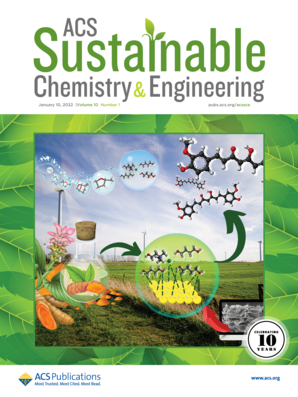新纳入环境社会治理评级上市前和建立化学工艺技术
IF 7.1
1区 化学
Q1 CHEMISTRY, MULTIDISCIPLINARY
引用次数: 0
摘要
对于可持续和创新的上市前制造技术,通常只有运营这些技术的小公司提供有限的数据。这种限制不允许在这种情况下应用传统的环境社会治理(ESG)评级方法。鉴于ESG报告是一项杰出的财务增长工具,这使得新兴技术对投资者和股东处于不利地位。为了弥补这一差距,我们提出并设计了一种新的ESG评估技术来评估传统(TRL 7-9)和新兴的化学工艺技术(TRL 4-6)。这种方法挑战了目前反对采用具有未来但不确定经济收益前景的新技术的经济论点。从历史上看,ESG方法侧重于评估组织,包括公司。我们提出了另一种方法,评估技术及其在企业环境中的应用。本研究从摩根士丹利资本投资公司(MSCI)已建立的商业ESG框架中制定了修改标准的原则。这些原则适用于MSCI主要ESG分级方法衍生的相关环境和社会标准。ESG行业重要性图和全球行业分类标准显示,治理支柱中的关键问题对化学和材料行业来说并不重要,而环境和社会支柱下的关键问题在ESG评估中被优先考虑。一个案例研究举例说明并展示了在澳大利亚的氨制造背景下提出的方法。它比较了传统的蒸汽甲烷重整和哈伯-博世(HB)转化的集中式氨生产与使用高温等离子体(HTP)和绿色电动迷你哈伯-博世工艺(e-mini-HB)的替代性区域上市前生产。上市前技术具有环境等级高、社会等级低的特点,可为新兴HTP/e-mini-HB公司提供商业建议。由于环境得分具有较高的MSCI-ESG权重因子,因此上市前HTP/e-mini-HB技术的ESG总体评级更高。本文章由计算机程序翻译,如有差异,请以英文原文为准。

Novel Incorporation of Environmental Social Governance Ratings for Premarket and Established Chemical Process Technologies
For sustainable and innovative premarket manufacturing technologies, there is only limited data available from the typically small companies that operate them. This limitation does not allow for the application of conventional environmental social governance (ESG) rating methodologies in such cases. This puts emerging technologies at a disadvantage to investors and shareholders given that ESG reporting is an eminent financial growth instrument. To compensate for this gap, a novel ESG evaluation technique is proposed and designed to assess both traditional (TRL 7–9) and emerging chemical process technologies (TRL 4–6). This approach challenges present economic arguments against adopting new technologies with future, yet uncertain, prospects for economical gain. Historically, ESG methodologies have focused on evaluating organizations, including companies. We propose an alternative approach, evaluating technologies and their applications in an entrepreneurial context. This study developed principles to modify criteria from the established commercial ESG framework of Morgan Stanley Capital Investment (MSCI). These principles were applied to relevant environmental and social criteria derived from MSCI’s primary ESG grading methodology. The ESG Industry Materiality Map and the Global Industry Classification Standard reveal that critical issues within the governance pillar are not deemed highly significant for the chemical and materials sectors, while pivotal issues under the environmental and social pillars are prioritized in ESG evaluations. A case study exemplified and demonstrated the proposed approach in the context of ammonia manufacturing in Australia. It compared traditional centralized ammonia production using steam methane reforming and Haber–Bosch (HB) conversion with the alternative regional, premarket production using high-temperature plasma (HTP) and green, electric mini-Haber–Bosch processes (e-mini-HB). The premarket technology is superior in environmental rating and inferior in social rating, which can be used to provide commercial advice to emerging HTP/e-mini-HB companies. As the environmental score has a higher MSCI-ESG weight factor, a superior overall ESG rating is determined for the premarket HTP/e-mini-HB technology.
求助全文
通过发布文献求助,成功后即可免费获取论文全文。
去求助
来源期刊

ACS Sustainable Chemistry & Engineering
CHEMISTRY, MULTIDISCIPLINARY-ENGINEERING, CHEMICAL
CiteScore
13.80
自引率
4.80%
发文量
1470
审稿时长
1.7 months
期刊介绍:
ACS Sustainable Chemistry & Engineering is a prestigious weekly peer-reviewed scientific journal published by the American Chemical Society. Dedicated to advancing the principles of green chemistry and green engineering, it covers a wide array of research topics including green chemistry, green engineering, biomass, alternative energy, and life cycle assessment.
The journal welcomes submissions in various formats, including Letters, Articles, Features, and Perspectives (Reviews), that address the challenges of sustainability in the chemical enterprise and contribute to the advancement of sustainable practices. Join us in shaping the future of sustainable chemistry and engineering.
 求助内容:
求助内容: 应助结果提醒方式:
应助结果提醒方式:


